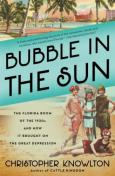
by Christopher Knowlton
Paperback- $17.99
Click on the ORANGE Amazon Button for Book Description & Pricing Info
Overall rating:
How would you rate this book?
Member ratings
Bubble in the Sun
This is such an interesting book, though very long and detailed. It explains the history of Florida’s building boom and connects it to The Great Depression. Florida was fertile and ripe for Real Estate investment. The weather and opportunities for vacation were enormous. Boating, swimming, and beaches inspired the success of communities and hotels. The rich and famous were drawn to this playground, as well as the tourist and just plain curious. The environment and social life were easy to enjoy, until nature intervened. Weather in Florida can be capricious.
Waterfront homes were very desirable. Communities were designed to be independent, offering services to the residents. Well-known names, Mizner, Urban, Douglas, Flagler, Ford, Collier, White, Fisher, Wyeth, investors, architects and builders, and so many others became wealthy and well-known because of Florida’s growth. Not all involved were stellar personalities, but they were innovative and demanding. All were driven by ambition and eventually, greed. Many had already, or soon would, achieve fame elsewhere.
Clearing land, road construction, and the housing boom soon put Florida on the map. Miami Beach, Palm Beach and Coral Gables became centers of hospitality for certain people of “acceptable backgrounds”. The hoi polloi was not welcome. As roads expanded access, cars eliminated horses, machinery improved and remote areas were developed and expanded, the growth continued. The growth and development did not bring advantages to everyone, however. The super rich with acceptable backgrounds, were the residents. Blacks were not welcome, except as employees, or perhaps as work crews from prisons. They were slowly moved from the prime property. Jews were not welcome either. Indigenous people provided entertainment. The rich and famous preferred to be embraced by their own kind. Florida served that need. It was being developed, at first, for the high and the mighty. Only later, was consideration given to those on lower rungs of the ladder.
So many prominent names were involved in the Florida boom. Firestone, Chevrolet, Penny, Stutz, Waugh, Wyatt, Singer, Ziegfeld, Douglas, Hutton, Johnny Weissmuller, Jack Dempsey, Josephine B, Al Capone and Ponzi, criminals and many others of political fame are just a few mentioned. As Miami Beach began to rival Palm Beach under the guidance of Carl Fisher, The Roaring Twenties roared, but at the end of the decade it whimpered with the rest of the country.
The origins of Mar A Lago, The Boca Raton Resort, The Breakers, Hobe Sound, the Cocoanuts, the original owner of the Hope Diamond, the creation of Singer Island, Fisher Island, Coral Gables, Boca Raton, Fort Lauderdale, The Royal Poinciana, The Everglades Club, etc. are all revealed as the growth of Florida in the Roaring Twenties is tied to The Great Depression. There are fun facts and tragic facts. In some places money poured in, lots were sold, but no houses were built. They were akin to stocks on Wall Street, sold and resold for the market price which seemed to keep rising. Money flowed from the North to the South and the financial systems from whence the money came began to suffer. The message was controlled by the movers and shakers and the banks and newspapers were heavily invested in by them, compromising their freedom to act responsibly and reveal the cracks forming. It doesn’t sound like much has changed today.
The ever-expanding growth robbed the state of its natural resources. Wild life and natural inhabitants were removed. Magnificent neighborhoods were created, with access to beautiful beaches, but it altered the natural state of the Everglades permanently. The building and progress also robbed the state of its diversity in certain places, as those living there were forced out as gentrification began and luxurious homes appeared where their homes once stood. Environmentalists were slow to react, and there were few, though eventually they would succeed in some small way, to save The Everglades. The land was bled of water as roads were built. Native life and insects suffered. The Everglades, populated by all sorts of wild life underwent tremendous negative changes that would be felt for years to come. Fashion trends were created, with some considered shameful, as in skimpier bathing suits. Greed propelled the continued expansion of Florida as it also promoted the decline of morality and ethics. It encouraged drinking, sex, and frivolity, in the locations developed.
The character flaws as well as the achievements of many of those involved is detailed and illuminating, especially about those were able to accomplish this gargantuan feat. The personalities were sometimes larger than life with pets that were also unusual. Monkeys, kinkajous and elephants were buddies. The lack of regulations, weather, business conditions, people’s choices coupled with greed, altered the image of Florida. The money invested was in danger when the business climate changed, but the banks were compromised and warnings went unheeded. So, did Florida’s expansion and then decline, cause the market to crash? After reading this, you will certainly believe it was a factor.
Book Club HQ to over 88,000+ book clubs and ready to welcome yours.
Get free weekly updates on top club picks, book giveaways, author events and more








